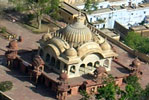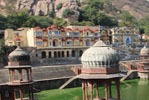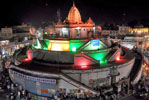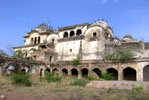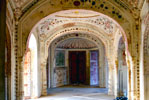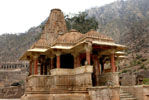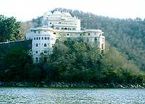|
Alwar is 150 km form Jaipur and 170 km from Delhi. Alwar is nested between a cluster of small hills of the Aravalli range. Perched on the most prominent of these hills is a massive ancient Rajput state, formerly known as Mewat, Alwar was nearest to the imperial Delhi.
The people of the state did not accept any external interferences and daringly resisted against foreign invasions. In the 12th and 13th centuries, they formed a group and raided Delhi. But finally sultan Bulban (1267 A.D. - 1287 A.D.) Suppressed them, bringing the area
under the Muslim Rule. In 1771 A.D. Maharaja Pratap Singh, a Kuchhwaha Rajput belonging to the clan of Jaipur's rulers, won back Alwar and founded a principality of his own. A part from its long history, the city has a rich natural heritage with some beautiful lakes and
picturesque valleys thickly wooded in parts. Some of the finest variety of birds and animals are spotted here. Alwar has one of the finest wildlife sanctuaries in Rajasthan-Sariska, which is an excellent tiger country.
TOP
PLACES OF INTEREST ARE:
The Fort: This huge fort with its ramparts stretching 5 km from north to south and 1.6 km from east to west, stands 304 metres above the city and 595 metres above the sea level, constructed before the rise of the Mughal empire. Babar had spent a night at this fort
and took away the hidden treasures to gift to his son, Humayun. Akbar's son, Jahangir had also stayed here for some time during his exile. The place where he stayed as called Salim Mahal. The fort was finally annexed by maharaja Pratap singh in 1775 A.D. It is a
forbidding structure with 15 large and 51 small towers and 446 opening for musketry, along with 8 huge towers encompassing it. The fort has several gates, Jai Pole, Suraj Pole, Laxman Pole. Chand Pole. Kishan Pole and Andheri Gate. Also there are remains of Jal Mahal,
Nikumbh Mahal, Salim Sagar, Suraj Kund and many temples.
City Palace: Built by Maharaja Vinay singh in the 18th Century, it is one of the most attractive palaces of Rajasthan. Its architecture is a blend of the Rajput and the Mughal styled. The lower floors of the palace are now occupied by government offices whereas
the upper floors are used as museum. This Museum has one of the finest collections of books (Sanskrit & Persian), archaeological finds, paintings (Mughal and Rajput school), and armory (swords, shields, daggers, rifles, pistols and other arms.) Maharaja Vinay Singh
Was a great patrons of the arts. He has a great taste for books and has an excellent collection in his library. It is said that he once paid a large amount of rupees fifty thousand to acquire a single manuscript of sheikh Sadi.
Behind the Alwar Palace is a mammoth tank (sagar) which nestles in the lap of the surrounding Aravallies. The Kund is just outside the Palace, but a part of the complex, has a number of chhatries & small temples with steps on all three sides. In the backdrop is the
Moosi Rani Ki Chhatri. It was built in the memory of Moosi Bai, queen of Maharaja Bakhtawar Singh. This cenotaph was erected by Maharaja Vinay Singh in 1816 A.D. the entire complex with the backdrop of the Aravallies envelopes you in its grandeur.
Hope Circus: This is another monument that attracts the attention of the visitors to Alwar. Located almost midway between the railway station and the city palace, this is a circular figure having flight of steps leading to the top from all four sides. It was
named after Miss Hope, daughter of Lord Linlithgow, the then Viceroy of India, on the occasion of his visit to Alwar in 1939-40 A.D.
Purjan Vihar (Company Garden): A Picturesque garden, laid out during the reign of Maharaja Shiv Dan Singh In 1868 A.D. the Garden has an enchanting setting called 'Shimla' which was built by Maharaja Mangal Singh in 1885 A.D. The lush surroundings and the cool
shades make it the idyllic visiting spot during summers.
TOP
MUSEUMS & ART GALLERIES:
Government Museum: Housed in the old City Palace, it has a unique collection of arms, bidri work, lacquered and ivory work, musical instruments, stuffed animals, beautiful brass and pottery works from Jaipur, Multan, Bengal and Ceylon, miniature paintings and
Persian and Sanskrit manuscripts. The museum is divided into three major sections, each housed in big hall. The first section contains various archaeological finds chiefly sculptures and inscriptions from the region. Items presented by the ruler of the former Alwar state
include mounted skins of wild animals like tiger, leopard and lion shot by them during their local and foreign excursions. The second section is the most important one as it contains various manuscripts in Persian including Gulistan of S'adi as well marvelous paintings
of Mughal and Rajput Schools. The paintings have been further divided into various sub-styles. The third section of the museum contains the armory of State rulers. Various kind of shields, swords, pistols, rifles, daggers and other items are on display.
TOP
EXCURSIONS
Vijay Mandir Palace: Situated at a distance of about 10 kms. from Alwar, this grand architectural wonder is a reminder of the regal opulence and glory of yesteryears. It was built by Maharaja Jai Singh in the year 1918. The beautiful stately palace stands atop a
hilly platform on the northern embankment of the lake created by the Vijay Sagar Bundh Dam. The Bundh is supported by two hills on the tributary of the Chuhar Siddh and was constructed in 1903. The Palace houses a Sita-Ram Mandir, which attracts thousands of devotees
during the Ramnavami celebrations.
Siliserh Lake: Siliserh Lake is only about 13 kms. from the city of Alwar. The Lake was built in 1845 A.D. by constructing an earthern dam between two hills to store the water of a small tributary of river Ruparel. When full, the total water spread covers an area
of about 10 sq kms. Adorned with domed cenotaphs, Siliserh Lake is picturesquely set amidst the forested slopes of Aravalli hills. The Open Terraces of the Siliserh Palaces Provide a breathtaking view of the water spread of the lake and its surrounding environment. This
tastefully built old palace is now converted into a tourist hotel and is managed by the Rajasthan Tourism Development Corporation. The basement of this four storied palace leads to the water level of the lake. A boat trip in the lake, particularly during winter season,
is a rewarding experience.
Tijara: Tijara is a historic town situated 48 kms North East of Alwar. Its old name was Trigartur. Tijara Fort situated on the crest of a hill has been famous for excavation of hidden treasure recently. It was the capital of Mewat and has a long and glorious
history of bravery and sacrifice. There is a popular Jain Temple, visited by lakhs of pilgrims every year.
Neemrana Ki Baori: Besides the old Fort, which is today a Heritage Hotel, Neemrana, located on the Jaipur-Delhi Highway & about 2.5 hours drive from Jaipur, also boasts of and old and very magnificent nine storied baori (step well). This stepwell was constructed
around 1700 A.D. by Thakur Janak Singh and the local population informs the visitors that there are nine storey above and tow below the water lever. It has 170 steps and as you descent, the entire construction becomes telescopic and the felling of entering the grotto
overwhelms. From the water source, you can see the rising tiered structure and the open key. The atmosphere is moist and cool. Both sides of this flight of steps are storey of verandahs which allowed the people to rest and relax. The pillars have a strong similarity to
the architectural design of the pillars of the old temple at Qutub Minar complex outside Delhi which was constructed by Prithviraj Chauhan. Legend has it that Neemrana, at one time, was the home of Chauhan Rajputs and one descendant of Prithviraj converted to Islam and
settled in Neemrana. This Baori is still in use, both for consumption of water by humans and for irrigation. The backdrop of the Neemrana Fort adds to the scenic environment.
Sariska: It is located on the Delhi - Alwar - Jaipur road (37 Km), nestled in the quaint surroundings of Aravalli this thickly wooded part throbs with life. It is a marvel of ecological adaptation and endurance. It is not only a delight for wildlife lovers but
also for the followers of art and archaeology. The Sariska Tiger Reserve, has a rich and varied animal population, the key fauna is the tiger. The sanctuary houses ruined temples, a fort, pavilions and palace. The Sariska Palace, built as a royal hunting lodge is a
magnificent piece of architecture.
Jai Samand Lake: To harved the flood waters of river Ruparel, Maharaja Jai Singh of Alwar started construction of a dam across the river. This picturesque lake was completed in 1920 A.D. and was name Jai Samand Lake. The 1.5 km. long embankment of the lake also
serves as a drive way. Around a dozen beautiful chhatris dome shaped Minar etc were built on the embankment of the Jai Samand Lake. Each Chhatri was built on a seven feet high raised lotus shaped platform carved out of red sandstone. A man-made island in the lake has a
beautifully laid out garden and spacious, lush green lawns. These lawns and the garden were used by the Maharaja for organizing special parties. The Jai Samand Lake is now controlled by the irrigation department of the state and has a good rest house.
Kesroli (12 km): The Hill Fort, Kesroli, sited atop the rare, dark Hornstone Breccia rocks, commands splendid agrarian views from its ramparts which rise to 50-65 meters/ 150-200 feet. Kesroli Fort makes an ideal base to visit the neighbouring palaces,
museums and sanctuaries of Alwar & Sariska. The origins of the seven-turreted Hill Fort Kesroli are traced back to over six centuries. It is reputed to have been built by the Yaduvanshi Rajputs, descendants of Lord Krishna, who converted to Islam in the mid-14th
century to be called Khanzadas. It subsequently changed hands, being conquered by the Mughals and the Jats before reverting to the Rajputs in 1775 when the princely state of Alwar was founded. It saw its golden period under the Ranawat Thakur Bhawani Singh (1882-1934),
renowned for his equestrian skills. Now it has been converted into a heritage hotel. |







